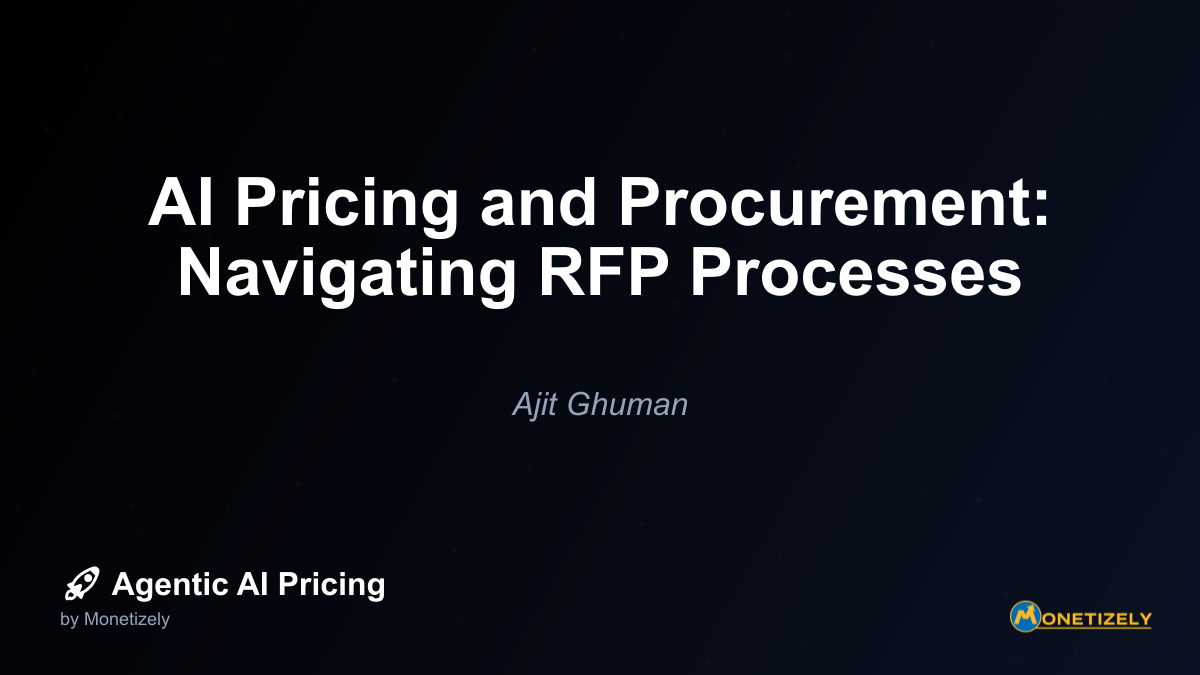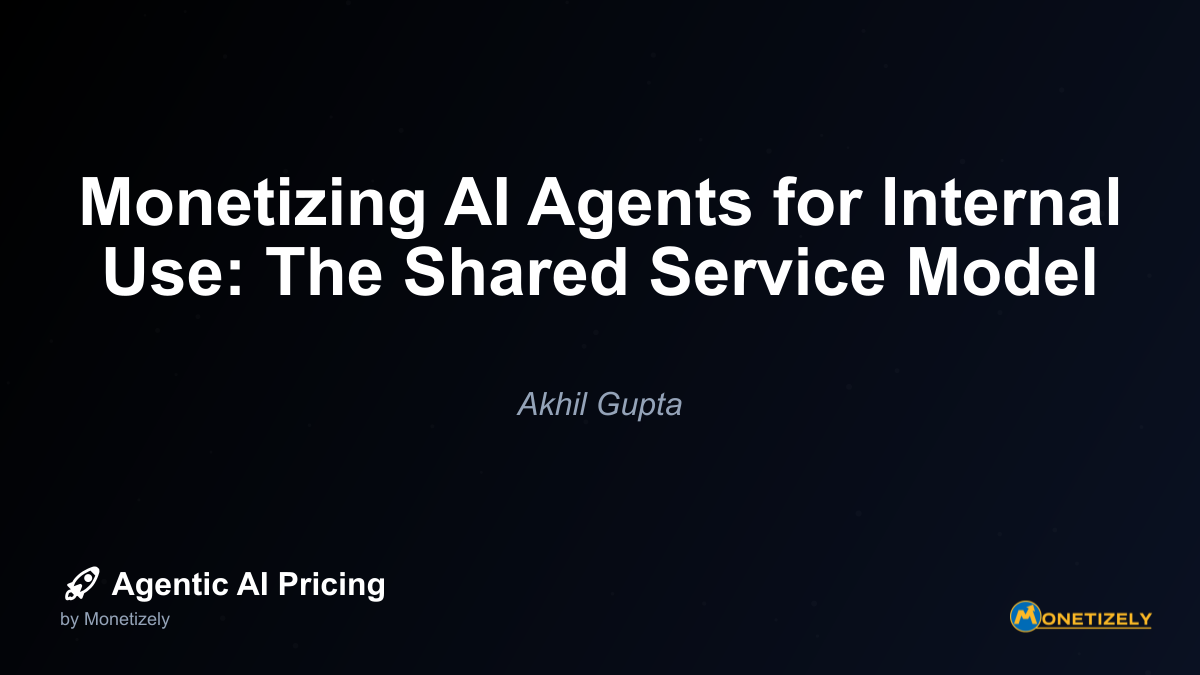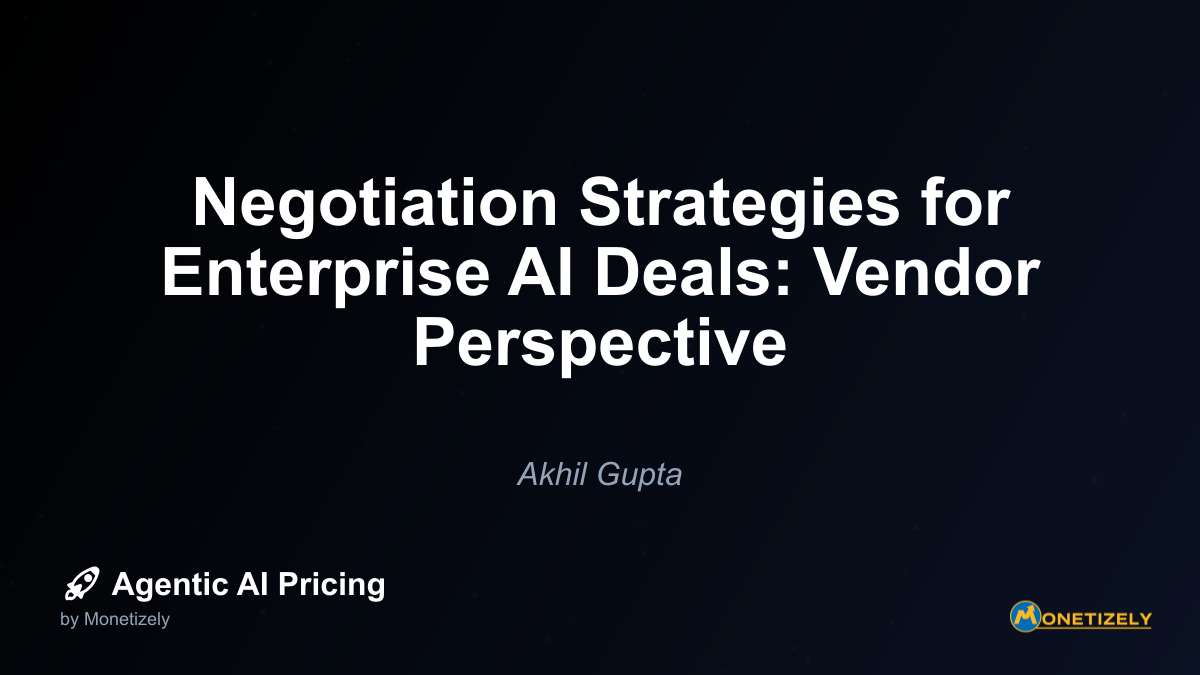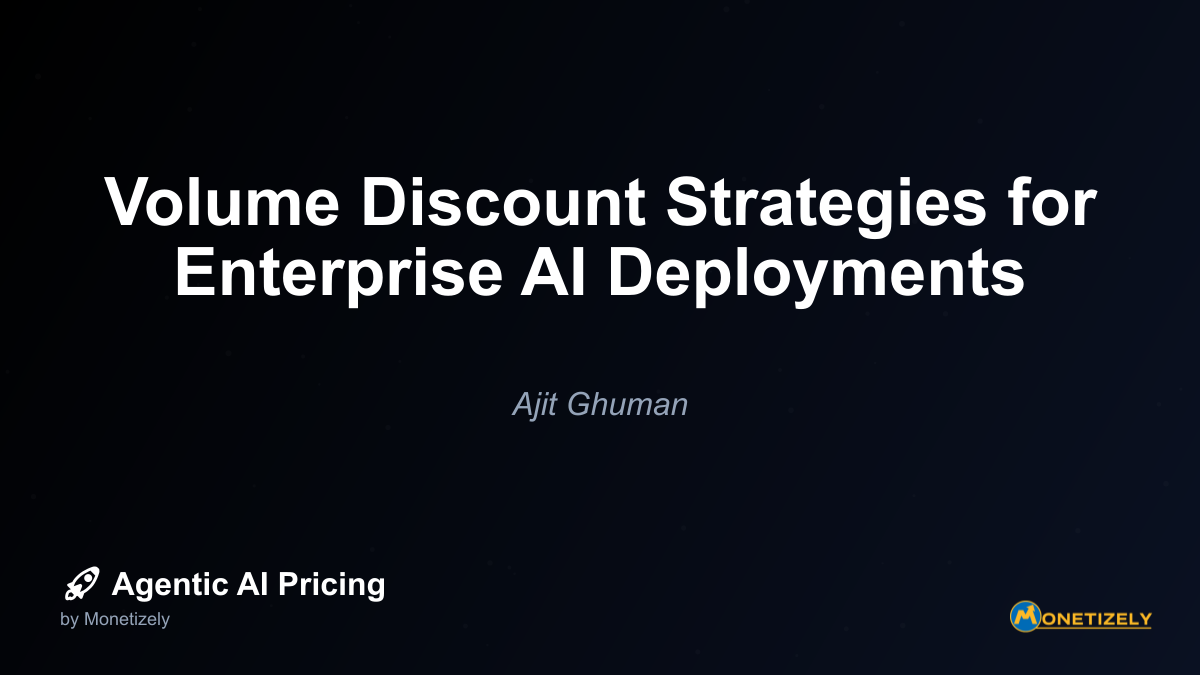· Ajit Ghuman · Enterprise · 12 min read
Internal Pricing Models: Charging for AI Agents Across Business Units
AI and SaaS Pricing Masterclass
Learn the art of strategic pricing directly from industry experts. Our comprehensive course provides frameworks and methodologies for optimizing your pricing strategy in the evolving AI landscape. Earn a professional certification that can be imported directly to your LinkedIn profile.
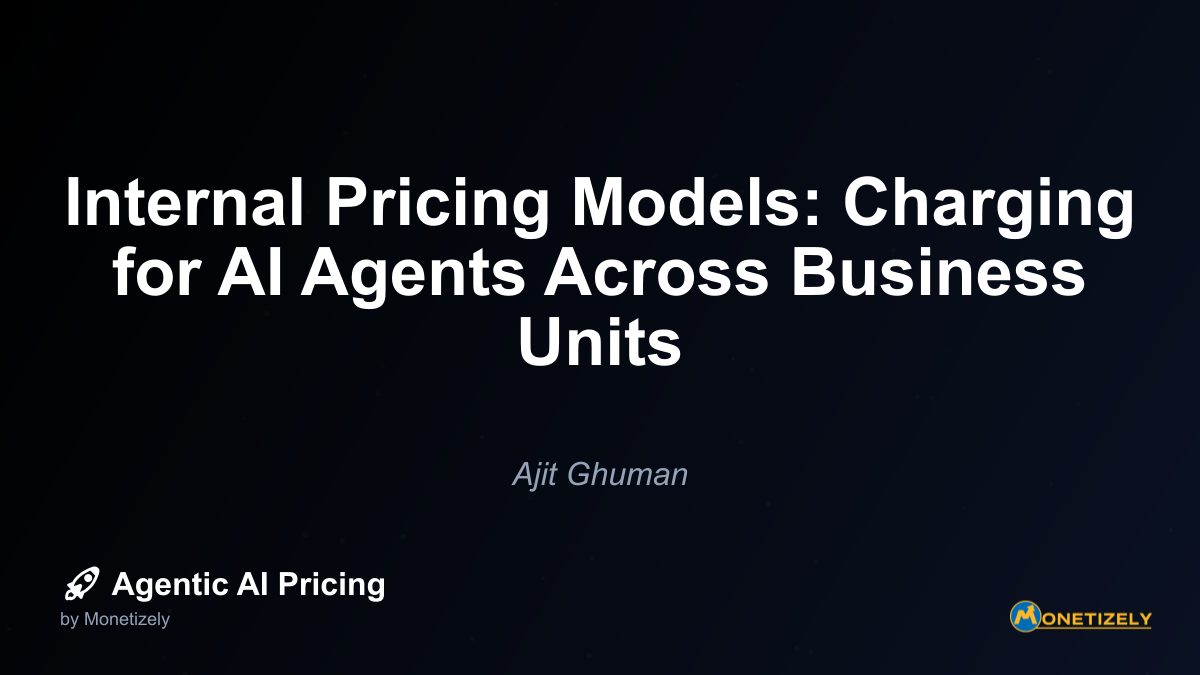
In today’s rapidly evolving enterprise landscape, organizations are increasingly deploying AI agents across business units to drive efficiency, innovation, and competitive advantage. As these AI resources become more integrated into core business operations, companies face a critical challenge: how to effectively implement internal pricing models that accurately reflect resource usage, promote efficiency, and align with business objectives.
The Evolution of Internal AI Pricing Models
Traditional internal pricing models, typically based on headcount or fixed allocations, are proving inadequate for the dynamic nature of AI resources. The variable compute demands, specialized infrastructure requirements, and scalable nature of AI agents require more sophisticated approaches to internal charging.
“Organizations are moving from flat per-user seat pricing to usage-based cost allocation, using metrics such as API calls, compute hours, tokens consumed, or AI agent tasks completed. This allows more accurate reflection of actual AI resource consumption, especially as AI generates variable workloads across units,” notes a 2025 report from Pilot.com on AI pricing economics.
The shift away from traditional seat-based pricing models is driven by several factors:
- Misalignment with AI consumption patterns: AI agents often perform tasks autonomously without direct human involvement, making per-user pricing models ineffective.
- Variable infrastructure costs: AI compute intensity and dynamic workloads create unpredictable resource utilization.
- Value-based considerations: The business value generated by AI agents varies significantly across use cases and departments.
Current Best Practices for Internal AI Pricing
Hybrid Pricing Models
Leading organizations are adopting hybrid pricing approaches that combine elements of different models to balance predictability with usage-based fairness.
| Pricing Model Component | Description | Application |
|---|---|---|
| Base subscription | Fixed monthly/annual fee | Provides budget predictability and covers baseline infrastructure |
| Usage-based charges | Fees based on actual consumption | Ensures fair allocation of costs based on resource utilization |
| Outcome-based components | Charges tied to business results | Aligns pricing with value delivered |
| AI agent “seats” | Licensing for autonomous AI users | Recognizes AI agents as digital workers consuming resources |
These hybrid models typically incorporate committed-use contracts for budgeting predictability combined with dynamic usage charges. Transfer pricing may be based on proxy metrics like compute units or credits that normalize various AI workloads, enabling inter-unit charging aligned with resource utilization and business outcomes.
Cost Allocation Methods
Accurate cost allocation is essential for fair internal pricing. Organizations are implementing several approaches:
- Granular usage tracking: Monitoring API calls, compute time, token consumption, and storage requirements at a detailed level.
- Differentiated pricing tiers: Creating different pricing levels based on the complexity and resource requirements of different AI agent types.
- Value-based allocation: Incorporating business outcome measures into pricing models to reflect the different value generated across business units.
“Organizations track GPU time, API call volume, and inference workloads carefully to allocate costs properly. Due to high cloud costs and variability in usage, many adopt usage-based or hybrid pricing instead of fixed fees to fairly assign costs across internal teams,” according to a 2025 analysis of AI cost factors.
Case Studies: Successful Internal AI Pricing Implementations
Alphabet (Google)
Alphabet reportedly generates roughly 30% of its coding internally via AI. The company has shifted from seat-based AI licensing to usage and outcome-based billing internally to reflect true AI utility, avoiding large margin losses associated with per-user seat pricing.
Challenges faced: Traditional seat pricing led to inflated costs and internal resistance; difficulty forecasting cloud infrastructure costs due to variable AI workloads.
Solutions: Implementation of hybrid models with heavy usage monitoring; investing in AI demand forecasting tools to provision cloud efficiently.
HubSpot
HubSpot uses a token-based pricing model internally for AI email generation where 1 token equals 1 AI-generated email. This shifts cloud cost risks internally to business units, requiring robust dashboarding to track token usage and prevent unexpected overages.
Challenge: Need for transparency and forecasting to align budgeting with usage spikes.
Solution: Developed detailed usage analytics and forecasting systems for internal stakeholders.
The True Costs of AI Agents: Frameworks for Calculation
To implement effective internal pricing, organizations must first understand the true costs of AI agents. Modern frameworks break these down into several key categories:
1. Compute Costs
Compute is often the largest and most variable cost, especially for generative AI models which require expensive GPUs or TPUs (e.g., NVIDIA H100, Google TPUs). Organizations track GPU time, API call volume, and inference workloads carefully to allocate costs properly.
Reports highlight that compute costs are rising sharply (an 89% increase projected between 2023-2025), making them a critical cost driver. Techniques like model quantization, pruning, or edge deployment can reduce these costs and should be factored into pricing models.
2. Data Costs
Data-related costs include data acquisition, cleansing, annotation, storage, and pipeline maintenance. These costs are often embedded in the AI development budget but increasingly assessed separately as data complexity grows (e.g., multimodal data for images, text, audio combined).
The cost of data increases with volume and heterogeneity; for example, multimodal systems significantly raise data pipeline complexity and associated costs.
3. Development Costs
Development depends on AI solution type: traditional ML solutions range from $10K–$100K; deep learning $100K–$500K; generative AI often exceeds $500K, sometimes reaching $5M+. Costs incorporate infrastructure, talent, algorithm training, experimentation, and integration with existing workflows or third-party APIs.
Development also varies by the AI type: simpler predictive analytics tools may start around $20K–$40K, whereas agent-based AI with autonomy and decision-making layers can exceed $120K.
4. Maintenance Costs
Maintenance includes ongoing model retraining, monitoring performance, updating for new data, security, compliance, and infrastructure upkeep. These costs are typically estimated as a percentage of the initial development and infrastructure cost, but for AI agents with continuous learning or real-time decision making, ongoing costs can be significant.
Pricing Different Types of AI Agents
Different types of AI agents have distinct cost drivers and value propositions, requiring tailored pricing approaches:
| AI Agent Type | Cost Drivers | Pricing Approach Considerations |
|---|---|---|
| Generative AI | High compute usage, large model sizes, API usage, multimodal data pipelines | Usage-based or hybrid pricing models to handle fluctuating GPU/API costs; value-based pricing tied to output quality and volume |
| Predictive AI | Moderate compute, historical data costs, model retraining | Fixed or subscription pricing often effective; cost depends on prediction frequency and accuracy requirements |
| Autonomous Agents | Integration complexity, level of autonomy, continuous real-time compute | Usage-based pricing aligned with task execution volume; mix of fixed base fees plus variable charges for task completion and compute usage |
Regulatory Considerations and Tax Implications
Internal pricing models for AI resources must navigate complex regulatory and tax considerations, particularly for global organizations:
Compliance with Tax Authorities: Transfer pricing for AI must align with international tax standards like OECD guidelines, ensuring prices reflect arm’s length principles even for intangible AI assets. Transparency in cost allocation methodologies is necessary to defend transfer pricing on audit.
Cross-Jurisdictional Coordination: Since AI resources may be shared globally, businesses must navigate spatial mismatches in governance and tax regulations across multiple jurisdictions, adapting transfer pricing methods accordingly.
Shared Responsibility Models: Depending on AI deployment type (SaaS, PaaS, IaaS), companies must delineate responsibilities for compliance, risk, and costs between internal units and external providers, affecting internal transfer pricing arrangements.
Governance Models for Shared AI Infrastructure
Effective governance is essential for managing shared AI infrastructure and implementing fair internal pricing:
Treat infrastructure as a first-class governance concern, embedding controls for security, ethics, compliance, and cost monitoring directly into the infrastructure layer, not as an afterthought.
Establish real-time infrastructure controls with observability for usage, faults, and compliance events, facilitating precise cost attribution and proactive governance.
Use multidisciplinary AI governance teams to continuously monitor system health, bias, and performance through dashboards and alerts, which also help validate transfer pricing fairness by monitoring resource efficiency.
Align infrastructure governance with broader sustainability and regulatory frameworks (e.g., Singapore’s Green Data Centre Roadmap or Model AI Governance Framework) to incorporate environmental and compliance costs into pricing models.
Key Metrics and KPIs for Internal AI Pricing Models
To measure the success of internal pricing models and optimize them over time, organizations should track a comprehensive set of metrics and KPIs:
Usage-Based Metrics
- Cost Per Query (CPQ): Measures average cost per AI interaction, breaking down by query type to identify resource-heavy requests.
- Token Utilization Ratio: Tracks ratio of input to output tokens in LLM-based agents to optimize pricing tiers according to actual consumption.
- Resource Utilization Peaks: Identifies high-demand usage periods to enable tiered or dynamic pricing during peak times.
Value-Delivery Metrics
- Resolution Rate: Percentage of queries resolved without human help, directly measuring AI contribution to efficiency and value.
- Time-to-Value (TTV): Time taken for AI to deliver meaningful results compared to manual processing, quantifying time savings.
- Error Rate and Quality Score: Accuracy and quality of AI responses; lower error rates justify premium pricing and indicate higher model maturity.
Financial KPIs
- Gross Margin: Revenue minus AI service delivery costs (compute, storage, licensing) as a percentage of revenue. Shows profitability health.
- Customer Lifetime Value (CLV): Total revenue expected per customer, helps align pricing strategy with long-term customer value.
- Customer Acquisition Cost (CAC): Cost to acquire new users/business units, checking cost-effectiveness of internal AI pricing and deployment.
- Burn Rate: For AI startups/internal units, tracks cash or cost outflow ensuring sustainability of pricing-driven operations.
Customer-Centric Metrics
- Price Sensitivity Index: Measures impact of pricing changes on adoption and usage rates, guiding pricing optimization.
- Feature Utilization Analysis: Identifies most/least used AI features to tailor tiered pricing and incentivize adoption of higher-value capabilities.
- Customer Satisfaction (NPS): Gauges user satisfaction with AI service pricing and performance.
Operational KPIs
- Infrastructure Utilization: Monitoring compute/storage usage to manage cost-effectiveness and adjust pricing accordingly.
- Deployment Frequency: Tracks how often AI models or features are updated, correlating with pricing adjustment needs based on evolving capabilities.
- Model Training Time: Efficiency of model development feeding into cost models.
Implementation Roadmap for Internal AI Pricing
Implementing internal pricing models for AI agents requires a structured approach and careful planning. Here’s a detailed roadmap with timelines and key milestones:
| Phase | Timeline | Key Activities and Milestones |
|---|---|---|
| 1. Discovery & Alignment | Month 0–1 | - Conduct value assessment interviews with business units. - Define baseline metrics and key value drivers. - Identify key stakeholders and form steering committee. |
| 2. Pricing Model Design | Month 1–2 | - Develop simple, outcome-aligned pricing model prototypes. - Design usage tracking and billing integration plans. - Establish success metrics for pilots. |
| 3. Infrastructure Setup | Month 2–4 | - Implement metering tools (API tracking, task logs). - Integrate billing engine with usage data. - Build reporting dashboards and alert systems. |
| 4. Pilot Deployment | Month 4–6 | - Launch pilot with select business units. - Provide stakeholder training on pricing and usage. - Collect feedback and monitor outcomes vs pricing. |
| 5. Iteration & Change Management | Month 6–8 | - Refine pricing model based on pilot learnings. - Address resistance with workshops and communications. - Establish dispute resolution and arbitration processes. |
| 6. Full Rollout | Month 8–12 | - Deploy pricing model across all business units. - Ensure ongoing support and training. - Track adoption and satisfaction metrics regularly. |
| 7. Continuous Optimization | Month 12 onward | - Monitor usage patterns, ROI, and pricing effectiveness. - Adjust pricing and billing rules as needed. - Maintain transparent communication channels. |
Stakeholder Management and Change Management
Successful implementation of internal AI pricing models requires effective stakeholder management and change management strategies:
Stakeholder Management
- Engage business unit leaders and finance early to explain pricing rationale, value propositions, and alignment with business outcomes.
- Involve sales or internal procurement teams to prepare them for questions about fairness, ROI, and discount policies.
- Establish ongoing communication channels to gather feedback and adjust models as necessary.
Change Management and Handling Resistance
- Prepare for resistance linked to perceived fairness or billing complexity, common when usage-based costs rise without clear value linkage.
- Use pilots or phased roll-outs with defined outcome-based benchmarks to build trust and demonstrate value.
- Train teams across units on how to interpret and use pricing and usage dashboards to minimize confusion and disputes.
- Implement conflict resolution processes (e.g., arbitration for disputes on outcome definitions) to handle grievances transparently.
- Emphasize transparency at all stages to reduce uncertainty and improve buy-in.
Ethical Considerations and Potential Pitfalls
Implementing internal pricing models for AI agents involves important ethical considerations and potential pitfalls that organizations must address:
1. Fairness and Avoidance of Bias
AI pricing models can unintentionally perpetuate or amplify biases if trained on non-representative or skewed data, leading to unfair cost allocations or discriminatory internal pricing that may disadvantage some units or projects unfairly. Bias risks are particularly acute if the model factors in sensitive or demographic data without safeguards.
2. Transparency and Explainability
Black-box pricing algorithms undermine trust because stakeholders (business units and internal users) may not understand how prices are calculated or why costs are assigned differently across units. Lack of transparency can erode confidence and impede accountability.
3. Accountability and Oversight
Due to complexity, organizations may struggle to fully grasp how AI models make decisions, making it hard to assign clear accountability for errors or unfair outcomes. This could create reputational risks and regulatory exposure if, for example, pricing influences internal resource allocation improperly.
4. Data Privacy and Security
Internal AI pricing models may rely on sensitive proprietary or employee-related data, which requires robust safeguards against breaches or misuse.
5. Impact on Innovation and Experimentation
Overly rigid or cost-focused pricing can disincentivize experimentation, as business units might limit AI use fearing high internal costs, thus reducing innovative potential.
Ensuring Fairness, Transparency, and Accountability
To address these ethical considerations, organizations should implement several safeguards:
Regular Bias Audits and Diverse Teams: Use standardized fairness metrics and conduct frequent audits to detect and mitigate biases. Employ diverse AI ethics advisory boards or committees to provide varied perspectives and oversight.
Clear, Meaningful Explanations: Adopt explainable AI (xAI) principles to provide tailored, understandable explanations of pricing logic to internal stakeholders. Ensure documentation clearly describes how models make recommendations.
Human Oversight and Ethical Governance: Create dedicated offices or roles charged with ethical AI use governance to review algorithms periodically and maintain accountability.
Data Protection Practices: Implement strong encryption, anonymization, and comply with data privacy regulations internally to secure data used for pricing.
Balancing Cost Recovery with Innovation and Experimentation
Organizations must strike a balance between recovering AI costs and fostering innovation and experimentation:
Tiered Pricing Models: Use tiered internal pricing that offers basic AI services at nominal or reduced rates for exploratory or experimental use, while applying higher rates for advanced or commercial-scale uses. This encourages experimentation while ensuring cost recovery on high-usage cases.
Flexible Pricing for Innovation Limits: Allow business units some AI usage quotas or discounted rates specifically earmarked for innovation projects, separating cost recovery from penalizing experimentation.
Transparent Communication and Trust Building: Clearly communicate the reasoning behind internal pricing to foster trust. When business units understand pricing logic is fair and transparent, they are more likely to engage constructively, balancing cost consciousness with innovation goals.
Alignment with Market and Business Objectives: Design internal pricing to reflect actual resource consumption and market realities without overburdening units, ensuring that pricing encourages efficient, value-driven AI usage rather than discouraging it.
Future Trends in Internal AI Pricing
The future of internal pricing models for AI agents will be shaped by several key trends:
Shift to Dynamic and Usage-Based Pricing Models
Internal pricing models will move towards metered and usage-based approaches that correlate cost with AI agent utilization, value delivered, and operational impact, rather than fixed fees or simple headcount allocation. This reflects the scalability of AI agents absorbing growth in transactional volume without proportional resource increases.
Integration of AI Maturity and Capabilities in Pricing
As AI technologies mature and become more autonomous and agentic, internal pricing will account for levels of AI sophistication—basic automation vs. advanced agentic AI with decision-making capabilities—and their differential value contribution. Pricing
Co-Founder & CEO
Ajit is the author of Price To Scale, a top book on SaaS Pricing and is the Founder of Monetizely. Ajit has led and worked in pricing and product marketing at firms like Twilio, Narvar and Medallia. His work has been featured in Forbes and VentureBeat. Ajit regularly consults with software companies from Seed stage to post-IPO on pricing strategy. Ajit is also a highly-rated co-instructor for 'The Art of SaaS Pricing and Monetization' on Maven.
Pricing Strategy Audit
Let our experts analyze your current pricing strategy and identify opportunities for improvement. Our data-driven assessment will help you unlock untapped revenue potential and optimize your AI pricing approach.

